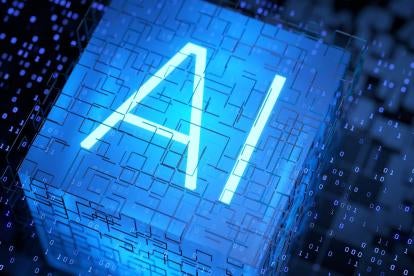This article was first published by ALM / Law.com in The Intellectual Property Strategist.
All of us have been exposed to and perhaps even overwhelmed by news about generative artificial intelligence (AI). Unlike machine learning technology that merely classifies or predicts, generative AI creates. Industry stalwarts and startups alike have launched generative models that can create new text, images, video, 3D models, and even software code — with the promise of more powerful and disruptive innovations to soon follow. A patent strategy informed by the unique considerations raised by generative AI will optimize protections for innovations in the field. Patent strategies should reflect the current legal landscape as well as anticipate potential future legal developments.
Part One of this series covers claim scope and inventorship. Part Two of this series covers subject matter eligibility, prior art, and future opportunities.
PART TWO
Subject Matter Eligibility
Patent claims directed to artificial intelligence, including generative AI, can raise subject matter eligibility issues. The inherent technical essence of generative AI might initially suggest the absence of Alice issues. Given its functional complexity, a generative model does not immediately conjure a mere mathematical concept or mental process, much less a method of organizing human behavior. However, generative AI is susceptible to the same subject matter eligibility issues that have sunk countless patent applications involving various machine learning technologies.
A common defect is claim scope. Many PTAB decisions teach that claims reciting capabilities of machine learning models are subject matter ineligible. For example, the PTAB in one case found claims ineligible after finding that a representative claim included only a “generic machine learning algorithm” to generate an output in an unspecified manner. See Ex parte Hussain, Appeal No. 2020-005406 (PTAB Feb. 18, 2021). In another case, the PTAB found that claims that expressly recited “machine learning” and its outputs were merely a concept performable by a “generic computer”, sealing the fate of the claims. See Ex parte Costello, Appeal 2021-000658 (PTAB June 7, 2021). In an example relating to generative AI in particular, the PTAB rejected claims directed to a neural network for creating advertisements as ineligible based in part on the absence of implementation details. See Ex parte Probell, Appeal 2021-003686 (Aug. 3, 2022). Many other PTAB decisions likewise have found claims that recited AI or machine learning techniques to be invalid under section 101.
U.S. Patent Office guidelines along with real-life prosecution experience fortunately provide a roadmap to avoid that fate for generative AI inventions. As set forth in Example 39, a discussion of technological challenges overcome by the inventive generative model should be set forth in detail in the patent application. In addition, details regarding training of the generative model, such as feature engineering related considerations and choices, should be described and claimed. A drafting strategy that leverages Example 39 and embraces detail in this manner will help to avoid and overcome subject matter eligibility issues. As discussed, wider claim focus on an application or a system to which a generative model may relate would also help support subject matter eligibility.
Prior Art Assessments
Pre-filing diligence to assess novelty and nonobviousness of inventions relating to generative AI will continue to be challenging for a host of reasons. For example, the pace of innovation has been and likely will continue to be particularly fast. Thus, the 18 month lag between filing and publication of patent applications, if they are published at all, forecloses a timely picture regarding current know how. As another example, given developing legal standards regarding generative AI, companies without informed patent strategies may be discouraged from filing patent applications from which prior art knowledge otherwise could be gleaned.
Notwithstanding these factors, a focused prior art search through patent office databases of major jurisdictions with fewer obstacles for patenting generative AI inventions may be productive. Prior art searches through technical papers may be especially helpful to obtain a more current baseline. Actual use of accessible generative AI models may also provide insights into the state of the art. In any event, companies in the generative AI space should appreciate that prior art searches conducted may capture only a fraction of the full extent of activity in the field.
Future Opportunities
Legal and regulatory standards around generative AI in the U.S. are likely to feel the influence of policy considerations. The unique power of generative AI to hasten critical scientific, economic, and military innovation enjoys widespread recognition. Some commentators have cautioned that, if Thaler-like rules effectively preclude patent protection for certain generative AI creations, such creations will be vulnerable to unrestricted exploitation by geopolitical rivals of the U.S. This threat may engender policy minded judicial reinterpretations of the patent statute, legislative interventions, or even administrative activism to address these concerns. For example, the US Patent Office is again seeking stakeholder input and public comment on the current state of AI technologies and related inventorship issues. Clearly, the patent system itself acknowledges that core issues remain unsettled yet deserve informed resolution. Thus, copyright questions implicated by generative AI (e.g., fair use), which have received the most significant press attention so far, are not the only pivotal intellectual property issues that require policy level attention.
The recent past provides a lesson: What if decisions almost ten years ago about whether to seek patent protection on vital software innovations relied solely on the Patent Office’s first positions on Alice Corp. v. CLS Bank International, 573, U.S. 208 (2014)? Accordingly, it may be prudent to anticipate possible future changes or adaptations to the law under which inventions produced by generative AI are not categorically excluded from patent protection. As an example of one type of generative AI innovation, software code would be a potential strong candidate for patent protection should the law allow. Apart from inventorship issues, the functionality of inventive software code resulting from a generative model would be no less patentable than the software related inventions on which thousands of U.S. patents are granted every year. One interesting consideration regarding a hypothetical patent on code functionality produced by generative AI would relate to enforcement power. Given its availability, open source would likely be a primary component of training data to develop a generative model for code production. Whether produced code would be encumbered by a typical copyleft license applicable to open source used to train the generative model and thus whether a patent on such produced code would be advisable appear to be related questions raised by generative AI.
Conclusion
Generative AI promises to bring fundamental change. A growing number of companies will vie to innovate and lead in this space. As with other technology paradigms, patent protection should play a critical role to secure innovations in generative AI from competitors. The unique and likely changing legal landscape around generative AI complicates formulation of a confident or definitive patent strategy now. However, given explosive growth anticipated for generative AI, companies vested in this technology would be ill-advised to adopt merely a wait and see approach.



 i
i


